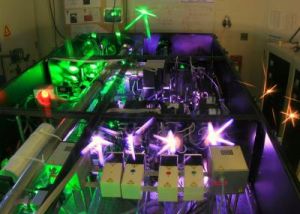


|

|
|
|
Home |
The Mil & Aero Blog
Experiment demonstrates beam orders of magnitude more powerful than the Airborne LaserSunday, February 17, 2008  Posted by John Keller Here's an eye-opener for a Sunday morning. Researchers at the University of Michigan demonstrated a 300-terawatt pulsed laser beam that lasts 30 femtoseconds. That beam duration isn't long -- just 30 millionths of a billionth of a second -- but I have to wonder what this might mean for laser weapons. Compare this power with the Airborne Laser (ABL), which is designed to shoot down intercontinental ballistic missiles from the platform of a Boeing 747 jetliner. The ABL is a "megawatt-class" laser, or power in the millions of Watts. This laser, I believe, can last longer than 30 femtoseconds; it takes a little longer than that to destroy a ballistic missile in flight, but consider the difference in power. The one at University of Michigan is terawatt-class. "If you could hold a giant magnifying glass in space and focus all the sunlight shining toward Earth onto one grain of sand, that concentrated ray would approach the intensity of a new laser beam made in a University of Michigan laboratory," according to a story in PhysOrg.com entitled Michigan laser beam believed to set record for intensity. "'That's the instantaneous intensity we can produce,' said Karl Krushelnick, a physics and engineering professor. 'I don't know of another place in the universe that would have this intensity of light. We believe this is a record.'" Explains PhysOrg.com: The record-setting beam measures 20 billion trillion Watts per square centimeter. It contains 300 terawatts of power. That's 300 times the capacity of the entire U.S. electricity grid. The laser beam's power is concentrated to a 1.3-micron speck about 100th the diameter of a human hair. A human hair is about 100 microns wide. This intensity is about two orders of magnitude higher than any other laser in the world can produce, said Victor Yanovsky, a research scientist in the U-M Department of Electrical Engineering and Computer Science who built the ultra-high power system over the past six years. The laser can produce this intense beam once every 10 seconds, whereas other powerful lasers can take an hour to recharge. The university researchers envision putting this kind of laser to work in applications like proton and electron beams for radiation treatment of cancer, but I'm thinking about what kind of potential it holds for laser weapons. If there's anyone out there who has a good idea, please let me know in a comment below. Harnessing this kind of power has to have the scientists at DARPA thinking. A detailed white paper about the experiment is online in .pdf format if you'd like to do a deep dive. I realize that the University of Michigan laser, an upgrade of the Hercules laser, is the size of several rooms, but the computer chip in your PC was once that size, too. The accompanying photo shows the amplifier for the Hercules laser as it fires. The photo is by Anatoly Maksimchuk, associate research scientist in the Department of Electrical Engineering and Computer Science at University of Michigan in Ann Arbor, Mich. << Home |
Welcome to the lighter side of Military & Aerospace Electronics. This is where our staff recount tales of the strange, the weird, and the otherwise offbeat. We could put news here, but we have the rest of our Website for that. Enjoy our scribblings, and feel free to add your own opinions. You might also get to know us in the process. Proceed at your own risk. 
John Keller is editor-in-chief of Military & Aerospace Electronics magazine, which provides extensive coverage and analysis of enabling electronic and optoelectronic technologies in military, space, and commercial aviation applications. A member of the Military & Aerospace Electronics staff since the magazine's founding in 1989, Mr. Keller took over as chief editor in 1995.  Courtney E. Howard is senior editor of Military & Aerospace Electronics magazine. She is responsible for writing news stories and feature articles for the print publication, as well as composing daily news for the magazine's Website and assembling the weekly electronic newsletter. Her features have appeared in such high-tech trade publications as Military & Aerospace Electronics, Computer Graphics World, Electronic Publishing, Small Times, and The Audio Amateur.
Courtney E. Howard is senior editor of Military & Aerospace Electronics magazine. She is responsible for writing news stories and feature articles for the print publication, as well as composing daily news for the magazine's Website and assembling the weekly electronic newsletter. Her features have appeared in such high-tech trade publications as Military & Aerospace Electronics, Computer Graphics World, Electronic Publishing, Small Times, and The Audio Amateur.
 John McHale is executive editor of Military & Aerospace Electronics magazine, where he has been covering the defense Industry for more than dozen years. During that time he also led PennWell's launches of magazines and shows on homeland security and a defense publication and website in Europe. Mr. McHale has served as chairman of the Military & Aerospace Electronics Forum and its Advisory Council since 2004. He lives in Boston with his golf clubs.
John McHale is executive editor of Military & Aerospace Electronics magazine, where he has been covering the defense Industry for more than dozen years. During that time he also led PennWell's launches of magazines and shows on homeland security and a defense publication and website in Europe. Mr. McHale has served as chairman of the Military & Aerospace Electronics Forum and its Advisory Council since 2004. He lives in Boston with his golf clubs.
Previous Posts
Archives
|
|||||
|
THE MAE WEBSITE AUTHORS ARE SOLELY RESPONSIBLE FOR THE CONTENT AND ACCURACY OF THEIR BLOGS, INCLUDING ANY OPINIONS THEY EXPRESS, AND PENNWELL IS NOT RESPONSIBLE FOR AND HEREBY DISCLAIMS ANY AND ALL LIABILITY FOR THE CONTENT, ITS ACCURACY, AND OPINIONS THAT MAY BE CONTAINED HEREIN. THE CONTENT ON THE MAE WEBSITE MAY BE DATED AND PENNWELL IS UNDER NO OBLIGATION TO PROVIDE UPDATES TO THE INFORMATION INCLUDED HEREIN.
|
||||||
|
|
Home | About Us | Contact Us | Corporate Website | Privacy Policy | Courage and Valor Foundation | Site Map
Also Visit: Laser Focus World | Vision Systems Design | Industrial Laser Solutions Copyright © 2007: PennWell Corporation, Tulsa, OK; All Rights Reserved. | Terms & Conditions | Webmaster |
Wednesday, February 20, 2008 12:15:00 PM EST
Wednesday, February 20, 2008 12:27:00 PM EST
In order to destroy something (break, melt, evaporate, ...) a certain minimal amount of ENERGY is needed. For example, melting 1 kg of iron (and prior to that heating it up from room temp. to the melting point) requires an energy input of roughly 1 MJ (million Joule), which is about 0.3 kWh.
Energy is power times time (a low power lasting for a long time can give as much energy as a high power which lasts only a short time). The 300 terawatt of this Michigan laser is an enormous power (all due respect!), but if we multiply that power by 30 femtoseconds we get 10 Joule, which can melt only 10 milligrams of iron...
The ABL is a continuous wave laser (in contrast to pulsed). Its 1 Megawatt of power must last for 1 second in order to yield the 0.3 kWh of energy needed to melt 1 kg of iron.
Thursday, February 21, 2008 3:33:00 AM EST